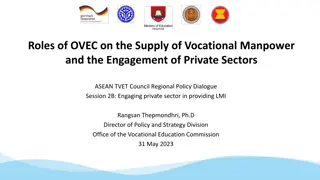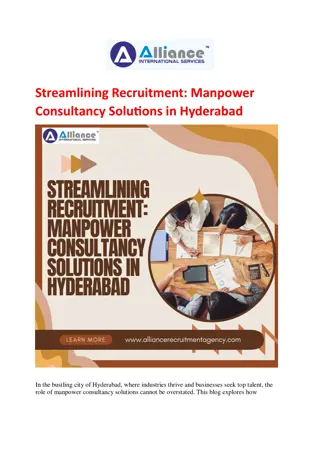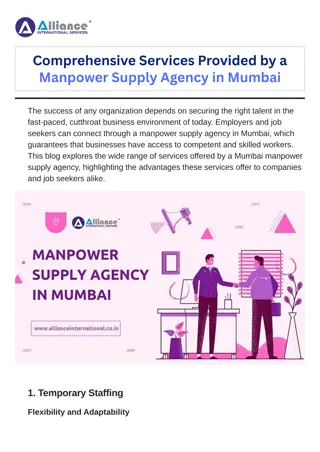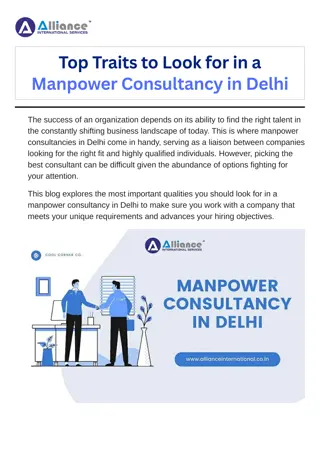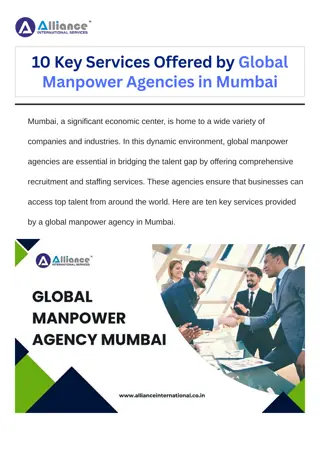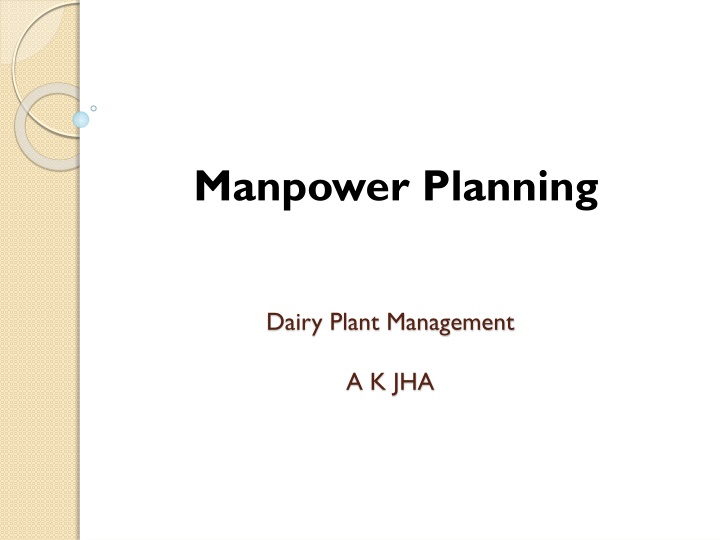
Manpower Planning and Personnel Management for Organizational Success
Learn about the importance of manpower planning and personnel management in achieving organizational goals. Explore the functions, objectives, and benefits of effective workforce planning to ensure the right people are in the right place at the right time.
Download Presentation

Please find below an Image/Link to download the presentation.
The content on the website is provided AS IS for your information and personal use only. It may not be sold, licensed, or shared on other websites without obtaining consent from the author. If you encounter any issues during the download, it is possible that the publisher has removed the file from their server.
You are allowed to download the files provided on this website for personal or commercial use, subject to the condition that they are used lawfully. All files are the property of their respective owners.
The content on the website is provided AS IS for your information and personal use only. It may not be sold, licensed, or shared on other websites without obtaining consent from the author.
E N D
Presentation Transcript
Manpower Planning Dairy Plant Management A K JHA
Personnel Management An organization needs different types of personnel or workforce organizational goals. Putting right man at right place in right number at right time is imperative. to accomplish Personnel management can be defined as obtaining, using and maintaining a satisfied workforce. It is a significant part of management concerned with employees at work and with their relationship within the organization.
Functions of Personnel Management Following are the four functions of Personnel Management Manpower Planning Recruitment Selection Training and Development
Manpower Planning Man power planning is also called Human Resource Panning. It aims at putting right kind of people in right number at the right place, right time, doing the right things for accomplishing the organizational goals. Definition of man power planning E.W. Vetter defined man power planning as "a process by which an organization should move from its current manpower position to its desired manpower position. Though planning management strives to have the right number and right kind of people at the right place at the right time, doing things which result in both the organization and the individual receiving maximum long-run benefit. According to Leon C. Megginson, man power or human resources planning is "an integrated approach to performing the planning aspects of the personnel function in order to have a sufficient supply of adequately developed and motivated people to perform the duties and tasks required to meet organizational objectives and satisfy the individual needs and goals of organizational members."
Objectives of Manpower Planning To recruit and retain the human resources of required quantity and quality. To foresee the employee turnover and make the arrangements for minimizing turnover and filling up of consequent vacancies. To meet the needs of the programmes of expansion, diversification etc. To foresee the impact of technology on work, existing employees and future human resource requirements. To improve the standards, skill, knowledge, ability, discipline etc.
Objectives of Man Power Planning To assess the surplus or shortage of human resources and take measures accordingly. To maintain congenial industrial relations by maintaining optimum level and structure of human resources. To minimize imbalances caused due to non- availability of human resources of the right kind, right number in right time and right place; To make the best use of its human resources and To estimate the cost of human resources.
Benefits of Man Power Planning Key to managerial functions: Human resources help in implementation of planning, organizing, directing and controlling . Efficient and effective utilization of human resources. Offsets uncertainty and changes and enables the organization to have right men at the right time and in the right place. Helps enhance productivity. It provides scope for advancement and development of employees through training, development etc. It helps to anticipate the cost of salary, benefits and all the cost of human resources, facilitating the formulation of budgets in an organization.
Benefits of Manpower Planning contd. To plan for physical facilities, working conditions and the volume of fringe benefits like canteen, schools, hospitals, conveyance, child care centres, quarters, etc. Helps in appraisal of human resources and decide incentives, promotion policies, etc. Deciding means and ways to improve skills and develop human resources to meet the organizational needs that leads to increased productivity, sales, turnover etc. It facilitates the control of all the functions, operations, contribution and cost of human resources.
Factors affecting man power planning External factors Government policies: Like labor policy, industrial relations policy, and policy towards reserving certain jobs for different communities. Level of economic development: Determines the level of man power planning in the country and thereby the supply of human resources in future. Business environment: External business environmental factors influence the volume and mix of production and the future demand for human resources. Information technology: Information technology brought amazing shifts in the business which includes: business process reengineering, enterprise resources planning and supply chain management. These changes brought unprecedented reductions in traditional human resources and increase in software specialists. Level of technology: Level of technology determines the kind human resources required.
Factors affecting man power planning Internal factors Company strategies: Policies and strategies relating to expansion, diversification, alliances etc. determine the quality and quantity of human resources demanded. Human resources policies of the company regarding quality of human resources, compensation, quality of work life etc. influence human resources plan. Job analysis: Fundamentally, human resources plan is based on job analysis. Job description and job specification. Thus, the job analysis determines the kind of employees required.
Internal factors contd. . Time horizon: Companies with a stable competitive environment can plan for the long run whereas firms with an unstable competitive environment can plan for only short term. Information: Any planning process needs qualitative and accurate information, which is equally important for human resources plan. Company's operations policy: policy regarding how much to produce and how much to buy from outside to prepare a final product influences the number and kind of people required..
Performance appraisal Some of the important features of performance appraisal may be captured as: Performance appraisal is the systematic description of an employee's job-relevant strengths and weaknesses. The basic purpose is to find out how well the employee is performing the job and establish a plan of improvement. Appraisals are arranged periodically according to a definite plan. Performance appraisal is not job evaluation. It refers to how well someone is doing the assigned job. Job evaluation determines how much a job is worth to the organization and, therefore, what range of pay should be assigned to the job. Performance appraisal is a continuous process in every large scale organization.




